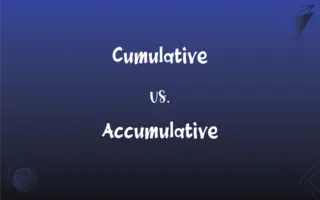Covalent Bonds vs. Ionic Bonds: What's the Difference?
Edited by Aimie Carlson || By Harlon Moss || Updated on October 7, 2023
Covalent bonds involve sharing of electron pairs between atoms; ionic bonds result from the electrostatic attraction between oppositely charged ions.

Key Differences
Covalent bonds form when two or more atoms share electrons to achieve a full outer shell, leading to a stable molecule. Ionic bonds, on the other hand, are formed when atoms transfer electrons, creating positively charged cations and negatively charged anions that are held together by electrostatic forces.
The strength of covalent bonds arises from the shared electron pair between atoms, often resulting in the formation of molecules like water (H₂O) or methane (CH₄). In contrast, the strength of ionic bonds is derived from the electrostatic attraction between ions, as seen in compounds like sodium chloride (NaCl) or magnesium oxide (MgO).
Covalent compounds typically have lower melting and boiling points compared to ionic compounds because the forces between molecules in covalent compounds are generally weaker than the ionic bonds in ionic compounds. Additionally, many covalent compounds are poor conductors of electricity, while ionic compounds can conduct electricity when dissolved in water or molten.
Polar covalent bonds occur when electrons are not shared equally between atoms, resulting in a molecule with a slight positive and negative end. In contrast, ionic bonds don't have a continuum of charge; one ion is positively charged, and the other is negatively charged.
The nature of atoms involved often determines whether a bond is covalent or ionic. Nonmetals typically form covalent bonds with each other, while metals and nonmetals usually form ionic bonds when combined.
ADVERTISEMENT
Comparison Chart
Formation Mechanism
Electron sharing between atoms.
Electron transfer from one atom to another.
Examples
H₂O, CH₄
NaCl, MgO
Electrical Conductivity
Typically poor conductors.
Conduct when molten or in solution.
Melting/Boiling Points
Generally lower.
Generally higher.
Atoms Involved
Often between nonmetals.
Typically between metals and nonmetals.
ADVERTISEMENT
Covalent Bonds and Ionic Bonds Definitions
Covalent Bonds
Nonmetallic atoms connected by electron partnerships.
The bonds in carbon dioxide (CO₂) are covalent bonds.
Ionic Bonds
Formed when atoms lose or gain electrons to achieve a full outer shell.
Calcium chloride (CaCl₂) is held together by ionic bonds.
Covalent Bonds
A bond formed by the sharing of electron pairs.
The bond between hydrogen and oxygen in water is a covalent bond.
Ionic Bonds
Electrostatic forces holding together positive and negative ions.
Potassium fluoride (KF) has an ionic bond between potassium and fluoride.
Covalent Bonds
A bond where atoms achieve full outer shells by sharing electrons.
The hydrogen molecule (H₂) is held together by a covalent bond.
Ionic Bonds
Bonds between metal cations and nonmetal anions.
The bond in magnesium oxide (MgO) is ionic.
Covalent Bonds
Chemical linkages involving shared electrons.
Methane (CH₄) has covalent bonds between carbon and hydrogen.
Ionic Bonds
Bonds formed by the electrostatic attraction between oppositely charged ions.
The bond in table salt (NaCl) is an ionic bond.
Covalent Bonds
Atoms bonded by mutual electron sharing.
The bond in a chlorine molecule (Cl₂) is covalent.
Ionic Bonds
Chemical linkages resulting from electron transfer.
The bond between sodium and chlorine in NaCl is ionic.
FAQs
Are covalent compounds generally good electrical conductors?
No, covalent compounds are typically poor conductors of electricity.
How do ionic bonds arise?
Ionic bonds result from the electrostatic attraction between oppositely charged ions.
What forms when atoms share electrons?
Covalent bonds form when atoms share electrons.
Can covalent bonds be polar?
Yes, polar covalent bonds occur when electrons are not shared equally.
How does salt dissolve in water given its ionic nature?
The ionic bonds in salt are disrupted by the polar water molecules, causing it to dissolve.
Can covalent bonds occur between identical atoms?
Yes, for instance, O₂ has a covalent bond between two oxygen atoms.
What charge do atoms have after losing electrons?
They become positively charged cations.
What role do electron pairs play in covalent bonding?
Electron pairs are shared between atoms in covalent bonds.
What happens to electron clouds in covalent bonding?
Electron clouds overlap in the region between the atoms in covalent bonding.
Are hydrogen bonds a type of covalent bond?
No, while they involve covalently bonded hydrogen atoms, hydrogen bonds are weaker intermolecular forces, not true bonds.
How do ionic bonds affect the properties of a compound?
Ionic bonds often result in compounds with high melting points and electrical conductivity.
Are all bonds purely ionic or covalent?
No, many bonds have both ionic and covalent character, depending on the electronegativity difference.
Which compounds have higher melting points, ionic or covalent?
Ionic compounds generally have higher melting points.
How do ionic compounds conduct electricity?
Ionic compounds conduct when dissolved in water or when molten.
Are ionic bonds formed between similar or dissimilar atoms?
Ionic bonds typically form between dissimilar atoms, especially metals and nonmetals.
What type of bond is present in pure metals?
Metallic bonds, which are different from covalent and ionic bonds.
Do ionic compounds form molecules?
No, ionic compounds form lattice structures, not distinct molecules.
Can atoms participate in multiple covalent bonds?
Yes, for example, carbon can form four covalent bonds.
Which elements typically form covalent bonds?
Nonmetals often form covalent bonds with each other.
What determines the type of bond formed between two atoms?
Elements' electronegativity and their position in the periodic table influence the bond type.
About Author
Written by
Harlon MossHarlon is a seasoned quality moderator and accomplished content writer for Difference Wiki. An alumnus of the prestigious University of California, he earned his degree in Computer Science. Leveraging his academic background, Harlon brings a meticulous and informed perspective to his work, ensuring content accuracy and excellence.
Edited by
Aimie CarlsonAimie Carlson, holding a master's degree in English literature, is a fervent English language enthusiast. She lends her writing talents to Difference Wiki, a prominent website that specializes in comparisons, offering readers insightful analyses that both captivate and inform.






































































